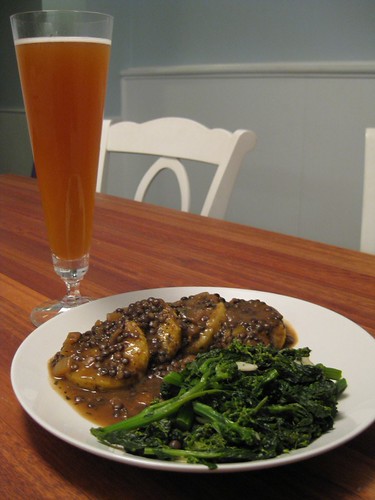For months I’ve been meaning to make the Dijon Mustard Lentil Sauce from the first Milennium Cookbook. The trouble was, I could never really make it fit into a meal. Serving a protein up in sauce form is a little strange and pouring it over tofu or seitan felt like too much protein. Since spring has returned, I’ve been cooking on the grill and a spring/summer favorite of mine is grilled polenta. The lentil sauce recipe suggests a hoppy beer and I have a homebrewed IPA on tap at the moment (the IPA didn’t turn out well enough to get into the complex recipe, but it is plenty hoppy.) With all the other ingredients on hand and some rapini (aka broccoli rabe) for a side, I cooked it up last night.
First, I cut up a roll of organic polenta into about 1/2 inch rounds and soaked them in a marinade for an hour or two.
Polenta Marinade:
1/4 cup olive oil
4 tablespoons champagne vinegar
1 teaspoon salt
1/2 teaspoon ground sage
1/4 teaspoon dried thyme
Next, I cooked the lentils in the pressure cooker for about 10 – 15 minutes and then started on the sauce. Here is the recipe directly from the book:
DIJON MUSTARD-LENTIL SAUCE
Makes 3 cups
With this sauce, I prefer using a red ale with a strong bitter hop flavor; stouts and heavy Belgian beers also work well. Any good beer of your choice will do except maybe fruit beer.
2 tablespoons corn starch
1 large yellow onion, cut into 1/3-inch dice
1 tablespoon olive oil (optional)
1/4 cup sherry or white wine
1/2 bunch fresh thyme leaves, or 2 teaspoons dried
One 12-ounce bottle of beer or non-alcoholic beer
1 cup apple juice
2/3 cup Dijon mustard
3 cups vegetable stock
1 cup cooked French lentils
1/4 bunch fresh tarragon, leaves only
1/2 teaspoon ground black pepper
2 teaspoons salt
Dissolve the corn starch in 1/4 cup cold water and set aside. In a saucepan over medium heat, cook the onion, oil, and sherry until the onions are lightly caramelized, about 15 minutes. Add the thyme leaves stir into the onions. Add the beer, apple juice, mustard and stock. Simmer until reduced by one third, about 20 minutes. Add the lentils, tarragon, pepper, and salt, and whisk in the cornstarch until the sauce is thick enough to coat the back of a spoon. Simmer 5 minutes, remove from heat, and use or set aside. Will keep up to one week in the refrigerator.
I did not use quite as much mustard – maybe 1/2 cup. There was plenty of mustard flavor with that. The rapini was sauted with a few cloves of sliced garlic in a tablespoon or two of olive oil and sprinkled with a little salt and pepper.

I paired with a Berliner weisse I had been aging since September. With the weather in the 60’s, it felt like a nice day to tap it. The recipe for the Berliner was very simple; however, I still managed to f it up. I used the recipe from Brewing Classic Styles, which calls for 2.75 lbs of wheat LIQUID malt extract (LME) and 2.75 lbs light LME. I was so accustomed to using DRIED malt extract (DME) that I used the same amounts of DME. Yes, a very stupid oversight, but the results were still great. I boiled for 15 minutes, adding .5 oz organic NZ Hallertau (8% AA) at 15 minutes. Primary fermentation at 68F with safale US-05, then transferred to a keg and pitched Wyeast Berliner weisse blend (3191).
The sauce is excellent. It’s rich and earthy with a pronounced Dijon flavor. There is definitely a slight citrusy sweetness that may have come from the beer, but it was subtle and buried under layers of other flavors. Maybe a Belgian or a hearty stout may have come through more. The bitterness of the rapini and the sourness of the Berliner complemented the sweetness of the sauce nicely. If I were to make this again – and I most likely will – I may switch out the polenta with grilled portabella mushrooms to give it a little more substance.


